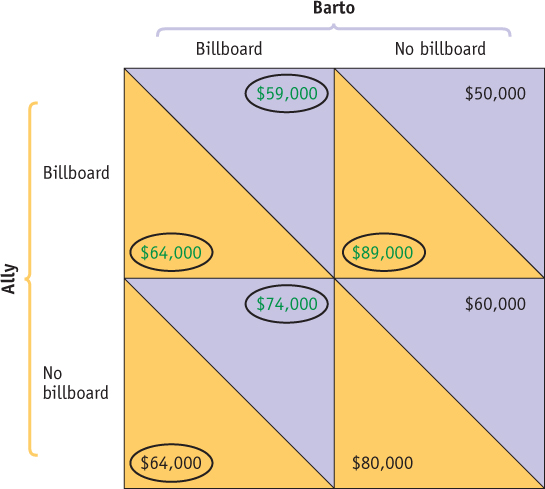Games Oligopolists Play
In our duopoly example and in real life, each oligopolistic firm realizes both that its profit depends on what its competitor does and that its competitor’s profit depends on what it does. That is, the two firms are in a situation of interdependence, whereby each firm’s decision significantly affects the profit of the other firm (or firms, in the case of more than two).
The study of behavior in situations of interdependence is known as game theory.
AP® Exam Tip
Game theory questions show up frequently on the AP® exam. To improve your performance on these questions, learn how to find dominant strategies, Nash equilibria, and the payoff for each firm.
In effect, the two firms are playing a “game” in which the profit of each player depends not only on its own actions but on those of the other player (or players). In order to understand more fully how oligopolists behave, economists, along with mathematicians, developed the area of study of such games, known as game theory. It has many applications, not just to economics but also to military strategy, politics, and other social sciences.
Let’s see how game theory helps us understand oligopoly.
The Prisoners’ Dilemma
The reward received by a player in a game, such as the profit earned by an oligopolist, is that player’s payoff.
Game theory deals with any situation in which the reward to any one player—
A payoff matrix shows how the payoff to each of the participants in a two-
When there are only two players, as in a lysine duopoly, the interdependence between the players can be represented with a payoff matrix like that shown in Figure 65.1. Each row corresponds to an action by one player; each column corresponds to an action by the other. For simplicity, let’s assume that each firm can pick only one of two alternatives: produce 30 million pounds of lysine or produce 40 million pounds.
| Figure 65.1 | A Payoff Matrix |
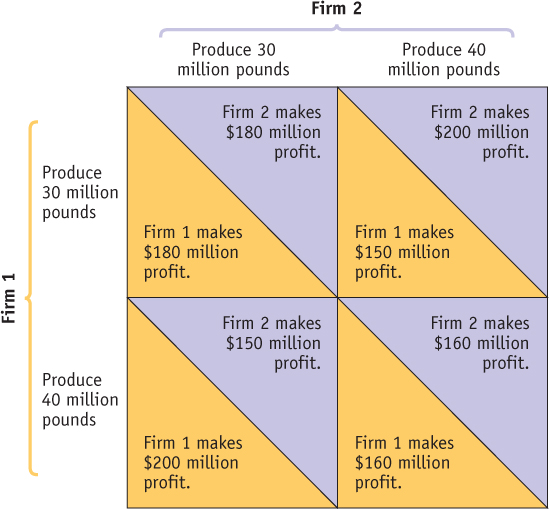
The matrix contains four boxes, each divided by a diagonal line. Each box shows the payoff to the two firms that results from a pair of choices; the number below the diagonal shows Firm 1’s profits, the number above the diagonal shows Firm 2’s profits.
AP® Exam Tip
Learn how to interpret a payoff matrix. These matrices won’t be color-
These payoffs show what we concluded from our earlier analysis: the combined profit of the two firms is maximized if they each produce 30 million pounds. However, either firm can increase its own profits by producing 40 million pounds if the other produces only 30 million pounds. But if both produce the larger quantity, both will have lower profits than if they had both held their output down.
The prisoners’ dilemma is a game based on two premises: (1) Each player has an incentive to choose an action that benefits itself at the other player’s expense; and (2) When both players act in this way, both are worse off than if they had acted cooperatively.
The particular situation shown here is a version of a famous—
Each player has an incentive, regardless of what the other player does, to cheat—
to take an action that benefits it at the other’s expense. When both players cheat, both are worse off than they would have been if neither had cheated.
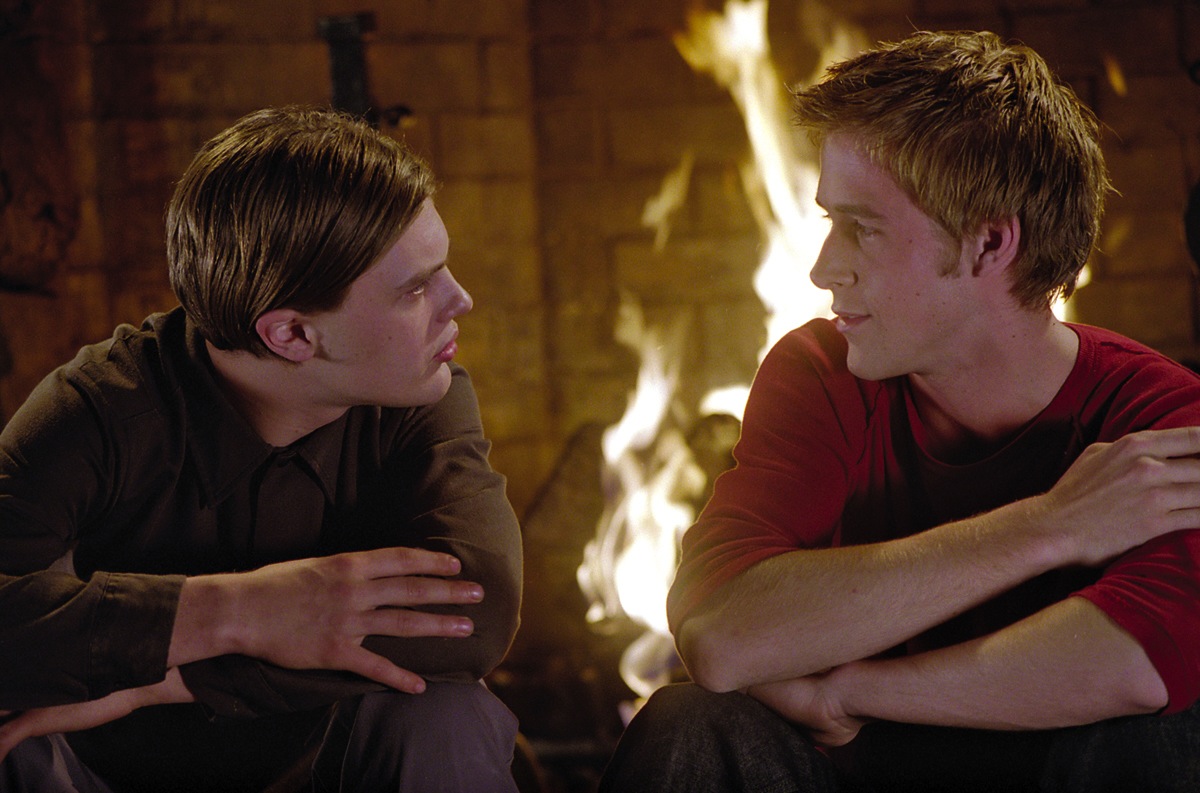
The original illustration of the prisoners’ dilemma occurred in a fictional story about two accomplices in crime—
So the police put the miscreants in separate cells and say the following to each: “Here’s the deal: if neither of you confesses, you know that we’ll send you to jail for 5 years. If you confess and implicate your partner, and he doesn’t do the same, we reduce your sentence from 5 years to 2. But if your partner confesses and you don’t, you’ll get the maximum of 20 years. And if both of you confess, we’ll give you both 15 years.”
Figure 65.2 shows the payoffs that face the prisoners, depending on the decision of each to remain silent or to confess. (Usually the payoff matrix reflects the players’ payoffs, and higher payoffs are better than lower payoffs. This case is an exception: a higher number of years in prison is bad, not good!) Let’s assume that the prisoners have no way to communicate and that they have not sworn an oath not to harm each other or anything of that sort. So each acts in his own self-
| Figure 65.2 | The Prisoners’ Dilemma |
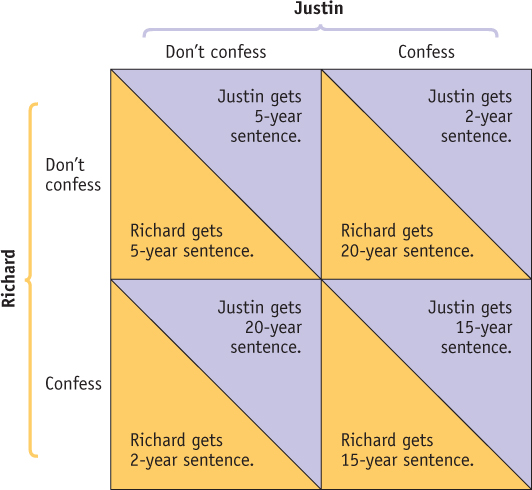
An action is a dominant strategy when it is a player’s best action regardless of the action taken by the other player.
The answer is clear: both will confess. Look at it first from Richard’s point of view: he is better off confessing, regardless of what Justin does. If Justin doesn’t confess, Richard’s confession reduces his own sentence from 5 years to 2. If Justin does confess, Richard’s confession reduces his sentence from 20 to 15 years. Either way, it’s clearly in Richard’s interest to confess. And because he faces the same incentives, it’s clearly in Justin’s interest to confess, too. To confess in this situation is a type of action that economists call a dominant strategy. An action is a dominant strategy when it is the player’s best action regardless of the action taken by the other player. It’s important to note that not all games have a dominant strategy—
So if each prisoner acts rationally in his own interest, both will confess. Yet if neither of them had confessed, both would have received a much lighter sentence! In a prisoners’ dilemma, each player has a clear incentive to act in a way that hurts the other player—
Prisoners of the Arms Race
Prisoners of the Arms Race
Between World War II and the late 1980s, the United States and the Soviet Union were locked in a seemingly endless struggle that never broke out into open war. During this Cold War, both countries spent huge sums on arms, sums that were a significant drain on the U.S. economy and eventually proved a crippling burden for the Soviet Union, whose underlying economic base was much weaker. Yet neither country was ever able to achieve a decisive military advantage.
As many people pointed out, both nations would have been better off if they had both spent less on arms. Yet the arms race continued for 40 years.
Why? As political scientists were quick to notice, one way to explain the arms race was to suppose that the two countries were locked in a classic prisoners’ dilemma. Each government would have liked to achieve decisive military superiority, and each feared military inferiority. But both would have preferred a stalemate with low military spending to one with high spending. However, each government rationally chose to engage in high spending. If its rival did not spend heavily, this would lead to military superiority; not spending heavily would lead to inferiority if the other government continued its arms buildup. So the countries were trapped.
The answer to this trap could have been an agreement not to spend as much; indeed, the two sides tried repeatedly to negotiate limits on some kinds of weapons. But these agreements weren’t very effective. In the end the issue was resolved as heavy military spending hastened the collapse of the Soviet Union in 1991.
Unfortunately, the logic of an arms race has not disappeared. A nuclear arms race has developed between Pakistan and India, neighboring countries with a history of mutual antagonism. In 1998 the two countries confirmed the unrelenting logic of the prisoners’ dilemma: both publicly tested their nuclear weapons, each seeking to prove to the other that it could inflict just as much damage as its rival.
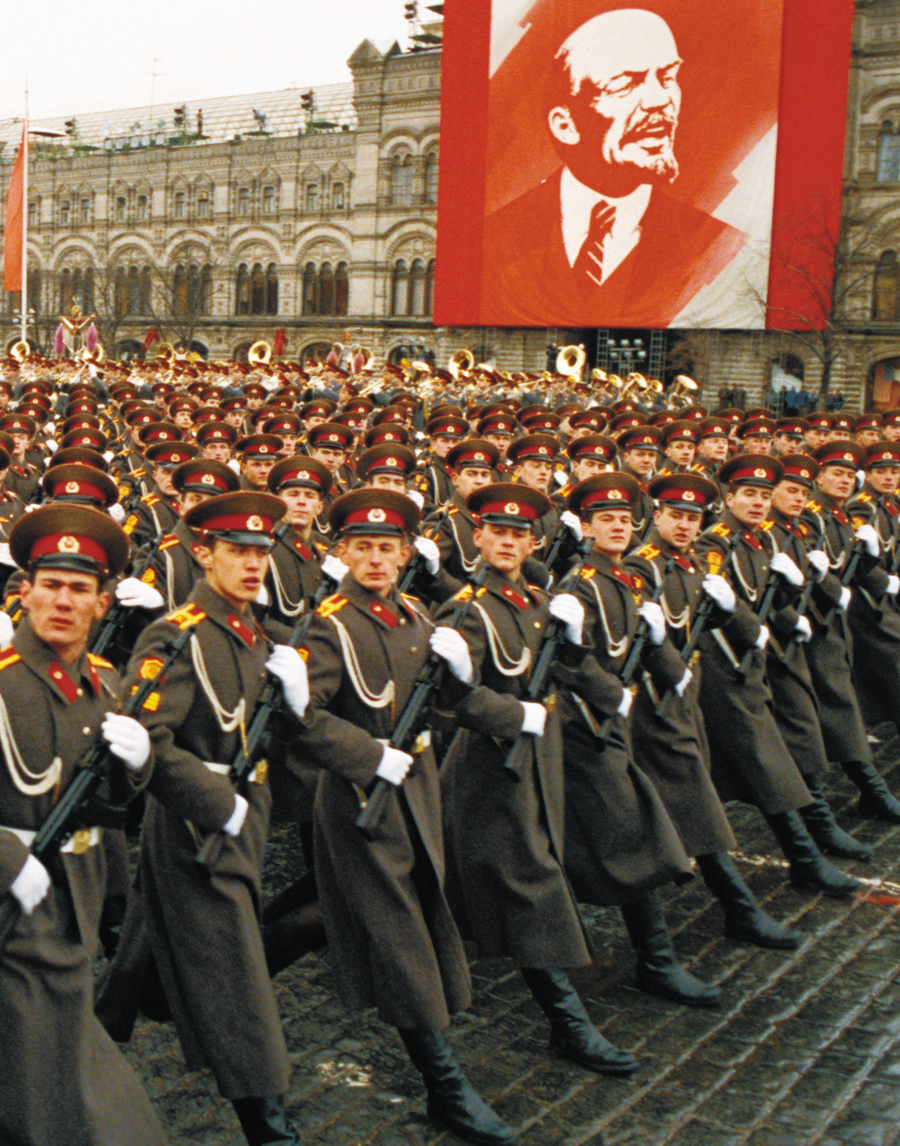
A Nash equilibrium, also known as a noncooperative equilibrium, is the result when each player in a game chooses the action that maximizes his or her payoff, given the actions of other players.

When Richard and Justin both confess, they reach an equilibrium of the game. We have used the concept of equilibrium many times in this book; it is an outcome in which no individual or firm has any incentive to change his or her action. In game theory, this kind of equilibrium, in which each player takes the action that is best for him or her, given the actions taken by other players, is known as a Nash equilibrium, after the mathematician and Nobel Laureate John Nash. (Nash’s life was chronicled in the best-
Now look back at Figure 65.1: the two firms face a prisoners’ dilemma just like Richard and Justin did after the crimes. Each firm is better off producing the higher output, regardless of what the other firm does. Yet if both produce 40 million pounds, both are worse off than if they had followed their agreement and produced only 30 million pounds. In both cases, then, the pursuit of individual self-
Prisoners’ dilemmas appear in many situations. The FYI above describes an example from the days of the Cold War.
More Games
We can use payoff matrices to analyze any number of games played by individuals and firms. The equilibria of many of these games differ from what we’ve seen in the prisoners’ dilemma. For example, in the prisoners’ dilemma, the Nash equilibrium happens to be an equilibrium of two dominant strategies—
Consider Richard and Justin, who are disheartened by the mutual distrust that led them to confess to their crime. After serving their jail time, each wants nothing more than to avoid seeing the other. On a Saturday night, they might each have to choose between going to the nightclub and going to the movie theater. Neither has a dominant strategy because the best strategy for each depends on what the other is doing. However, Richard going to the nightclub and Justin going to the movie theater is a Nash equilibrium because each player takes the action that is best given the action of the other. Richard going to the movie theater and Justin going to the nightclub is also a Nash equilibrium, because again, neither wants to change his behavior given what the other is doing. This game resembles those played by two firms that do not want to locate in the same area, or to advertise on the same website.
The following section explains tricks to identify dominant strategies and Nash equilibria using a payoff matrix. We’ll use these methods to analyze several games with varying outcomes.
Approaches and Applications Figure 65.3 provides a payoff matrix for the game of Richard and Justin trying to avoid each other. The numbers in the matrix represent the players’ levels of happiness, measured in utils. In each case, the utility levels are influenced by both the location and the presence or absence of the other player. For example, the upper-
| Figure 65.3 | A Game of Avoidance |
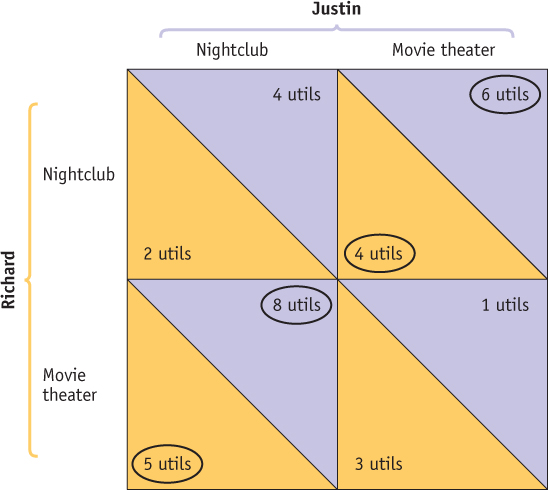
AP® Exam Tip
Whenever there are two circles in the same box, a Nash equilibrium exists.
Here’s a trick for finding dominant strategies and Nash equilibria. Begin by supposing that Justin goes to the nightclub. In the “Nightclub” column for Justin, we see that Richard receives 2 utils by going to the nightclub and 5 utils by going to the movie theater. Circle the best outcome for Richard, which is the 5 utils received by going to the movie theater. Then suppose that Justin goes to the movie theater. Circle the best outcome for Richard, which is to receive 4 utils by going to the nightclub.
Now look at things from Justin’s point of view. If Richard goes to the nightclub, the options for Justin are to receive 4 utils by going to the nightclub or 6 utils by going to the movie theater. Circle the best outcome for Justin: 6 utils. Finally, suppose that Richard goes to the movie theater. Circle the best outcome for Justin in that case, which is to receive 8 utils by going to the nightclub.
Justin has a dominant strategy if there are two circles around his outcomes in the same column. In this game Justin does not have a dominant strategy, because he has one circle in the “Movie theater” column and one circle in the “Nightclub” column. Richard has a dominant strategy if there are two circles around his outcomes in the same row. Here Richard does not have a dominant strategy, because he has only one circle in each row.
AP® Exam Tip
Whenever there are two circles in a column (or row) for a player, a dominant strategy exists.
A combination of strategies is a Nash equilibrium if the box representing that combination contains two circles. In this game, there are two circles in the box representing Richard going to the movie theater and Justin going to the nightclub, so that is a Nash equilibrium. The two circles in the box representing Richard going to the nightclub and Justin going to the movie theater indicate a second Nash equilibrium.
The same outcome of two Nash equilibria and no dominant strategy occurs when two grocery store chains consider opening a store in a town that can only support one grocery store. Just like Richard and Justin, if one is there, the other doesn’t want to be there. So if the two chains are Chain 1 and Chain 2, the two Nash equilibria are: Chain 1 there and Chain 2 not there, and Chain 2 there and Chain 1 not there. Whichever chain can commit to being in that town first has the first-
Sometimes firms face differing choices. For example, suppose that Juice Tree is deciding whether to raise its price on orange juice, while competitor Juice Max is deciding whether to spend more on advertising. Figure 65.4 shows hypothetical profits for each firm, depending on the chosen strategies. For example, if Juice Tree raises its price and Juice Max doesn’t advertise more, some of Juice Tree’s customers will switch to Juice Max, increasing Juice Max’s profit from $4 million to $6 million. In this case, Juice Tree’s profit increases from $5 million to $6 million, indicating that the price effect of receiving more per unit is larger than the quantity effect of losing customers. The story changes if Juice Max advertises more: Juice Tree’s profit decreases from $3 million to $2 million if it raises its price, because Juice Max is better able to draw attention to Juice Tree’s higher prices and attract its customers.
| Figure 65.4 | Differing Choices |
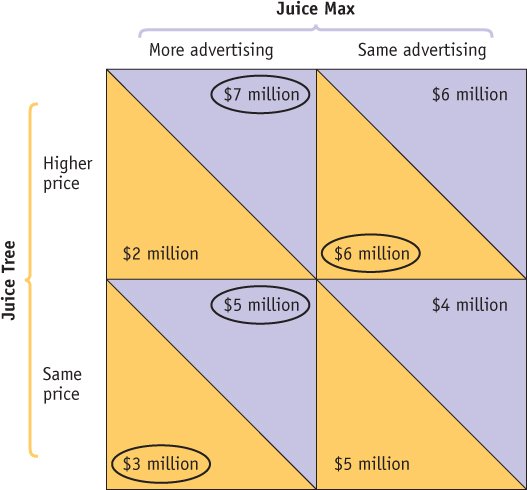
Using the circle trick, we find one Nash equilibrium where Juice Tree keeps its price the same and Juice Max advertises more. The two circles around Juice Max’s payoffs in the left column indicate that Juice Max has a dominant strategy of advertising more. Juice Tree does not have a dominant strategy because its best strategy depends on the strategy of Juice Max—
Spending more on advertising was a wise strategy for Juice Max, but the cost of more advertising can exceed the benefit. Suppose Ally and Barto offer competing painting services, and each must decide whether to rent a billboard to attract customers. Figure 65.5 shows each painter’s annual profits depending on the chosen strategies. Remember that oligopolists are not identical, so differing characteristics can result in differing payoffs for two firms in analogous situations. In this case, Barto is relatively unknown among the potential customers, and receives a net gain from billboard advertising regardless of Ally’s decision. If Barto does not rent a billboard, Ally receives a net gain of $5,000 from a billboard. But if Barto does rent a billboard, he attracts so many new customers that Ally cannot gain enough to cover the cost of a billboard, and Ally loses $4,000 by renting one.
| Figure 65.5 | Differing Payoffs |

Applying the circle trick, the two circles around Barto’s payoffs in the left column indicate that Barto has a dominant strategy of advertising. There are not two circles around Ally’s payoffs in any one row, so she does not have a dominant strategy. The two circles in the box for Ally not getting a billboard and Barto getting a billboard indicate that neither side would want to take a different action given what the other is doing, so that combination is a Nash equilibrium.
We can explore more possible outcomes by supposing that the annual cost of renting a billboard decreases by $4,000. As shown with green numbers in Figure 65.6, this increases each profit level associated with renting a billboard by $4,000. Notice that if Barto rents a billboard, Ally receives a profit of $64,000 with or without a billboard. Which number do we circle when applying the circle trick to two identical choices? Both! This indicates that Ally is indifferent between the two strategies if Barto has a billboard. If Barto doesn’t have a billboard, Ally earns more profit with a billboard. Because Ally is sometimes indifferent about having a billboard and sometimes she is better off with one, we describe having a billboard as a weakly dominant strategy for Ally. Having a billboard is again a dominant strategy for Barto. And now there are two Nash equilibria: both having a billboard, and Ally having no billboard while Barto does have a billboard. If Ally and Barto had to decide whether to rent billboards year after year, this would be considered a repeated game. The next module explains how repeated games create new options for strategy and cooperation.
| Figure 65.6 | Adjusting for Changes |
